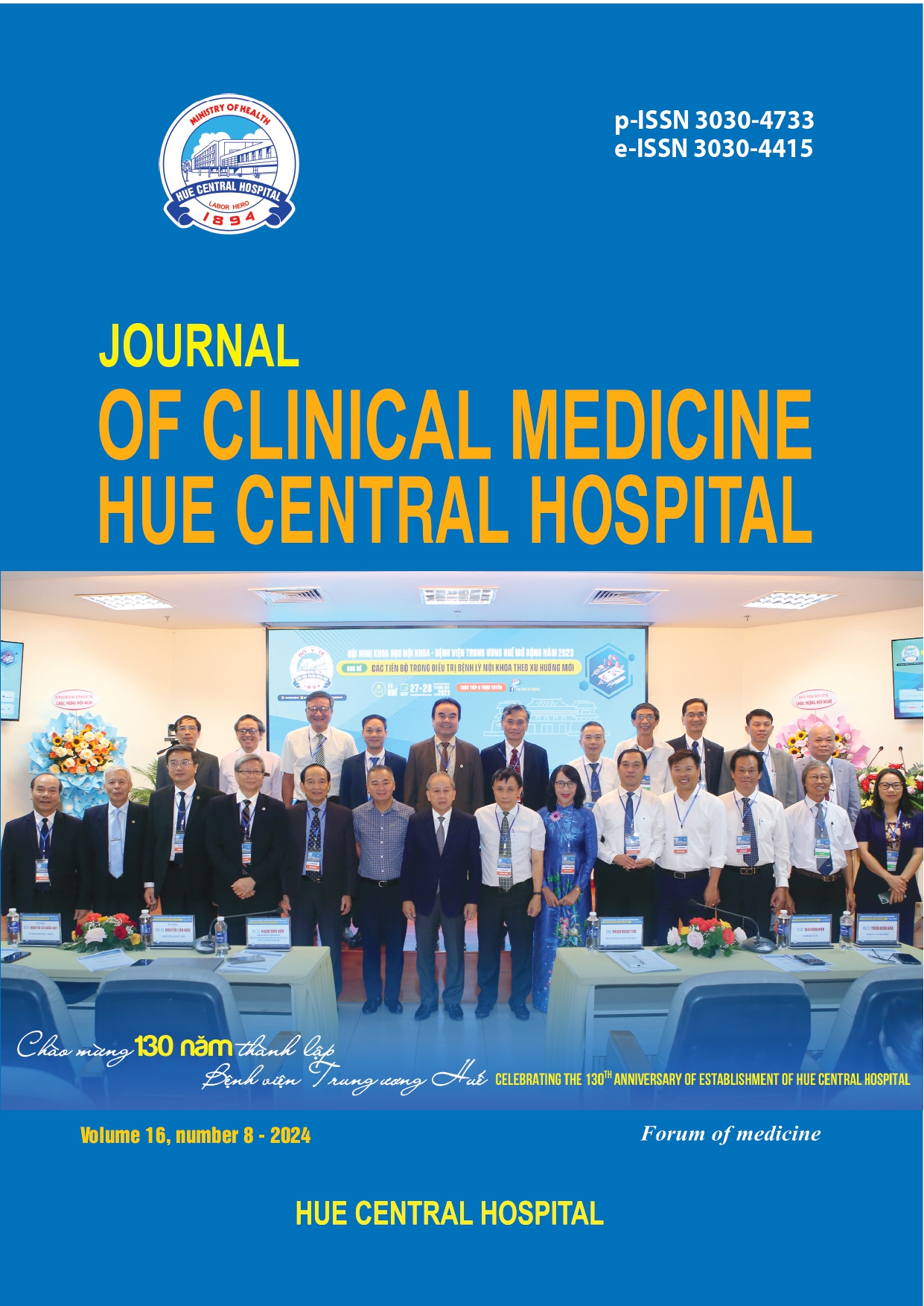Abstract
Background: Patients with metabolic syndrome are at high risk of morbidity and mortality from coronary artery disease. Understanding the characteristics of coronary artery lesions and the relationship with components of metabolic syndrome has important implications for treatment and prognosis. This study aims to survey the clinical and paraclinical characteristics and coronary artery lesions in metabolic syndrome patients with coronary artery disease at Ninh Thuan General Hospital; and evaluate the relationship and correlation between the characteristics and extent of coronary artery lesions and the components of metabolic syndrome.
Methods: Cross-sectional descriptive study on 89 metabolic syndrome patients with coronary artery disease treated as inpatients at the Department of Interventional Cardiology - Ninh Thuan General Hospital.
Results: The average age of the study subjects was 66.7 ± 12.8 years old. Patients with severe stenosis accounted for 89.9%, mainly type B and C lesions accounted for 93.3%; Multivessel lesions accounted for 78.7%. Low SYNTAX scores accounted for 61.8%, medium and high scores were 24.7% and 13.5%, respectively. Patients with increased waist circumference were 4.87 times more likely to have multivessel lesions than patients without increased waist circumference [OR = 4.87, 95%CI: (1.65 - 14.40), p = 0.006]; The risk of having severe coronary artery lesions was 3.96 times higher [OR = 3.96, 95%CI (1.21 - 12.91), p = 0.017]. Patients with >3 components of metabolic syndrome had a 3.75 times higher risk of multivessel lesions than patients with 3 components [OR = 3.75, 95%CI: (1.30 - 10.82), p = 0.011]; had 12.39 times the risk of severe lesions [OR = 12.39, 95%CI: (2.70 - 56.90), p = 0.0001]. There was a moderately statistically significant positive correlation between SYNTAX score and waist circumference (r = 0.345) and HDL-C (r = 0.320).
Conclusion: There was an association between the components and number of components of metabolic syndrome and coronary artery disease. There was a moderate positive correlation between SYNTAX score and waist circumference and HDL-C.
References
Knuuti J, Wijns W, Saraste A, Capodanno D, Barbato E, Funck-Brentano C, et al. 2019 ESC Guidelines for the diagnosis and management of chronic coronary syndromes. Eur Heart J. 2020;41(3):407-477.
Mensah GA, Fuster V, Murray CJL, Roth GA, Global Burden of Cardiovascular D, Risks C. Global Burden of Cardiovascular Diseases and Risks, 1990-2022. J Am Coll Cardiol. 2023;82(25):2350-2473.
Huong LK, Comments on the characteristics of metabolic syndrome in a group of patients with coronary artery disease. 2010, Ho Chi Minh City University of Medicine and Pharmacy.
Viet NL, Tuan PV, Hung PM, Hanh VD, Quang NN. Research on disease models in inpatients at Vietnam National Heart Institute during 5 years from 2003 to 2007. Journal of Vietnamese Cardiology. 2010;52:11-18.
McNeill AM, Rosamond WD, Girman CJ, Golden SH, Schmidt MI, East HE, et al. The metabolic syndrome and 11-year risk of incident cardiovascular disease in the atherosclerosis risk in communities study. Diabetes Care. 2005;28(2):385-90.
Alberti KG, Eckel RH, Grundy SM, Zimmet PZ, Cleeman JI, Donato KA, et al. Harmonizing the metabolic syndrome: a joint interim statement of the International Diabetes Federation Task Force on Epidemiology and Prevention; National Heart, Lung, and Blood Institute; American Heart Association; World Heart Federation; International Atherosclerosis Society; and International Association for
the Study of Obesity. Circulation. 2009;120(16):1640-5.
Virani SS, Newby LK, Arnold SV, Bittner V, Brewer LC, Demeter SH, et al. 2023 AHA/ACC/ACCP/ASPC/NLA/ PCNA Guideline for the Management of Patients With Chronic Coronary Disease: A Report of the American Heart Association/American College of Cardiology Joint Committee on Clinical Practice Guidelines. Circulation. 2023;148(9):e9-e119.
Sianos G, Morel MA, Kappetein AP, Morice MC, Colombo A, Dawkins K, et al. The SYNTAX Score: an angiographic tool grading the complexity of coronary artery disease. EuroIntervention. 2005;1(2):219-27.
Health VMo, Practice in the diagnosis and treatment of coronary artery disease. 2020, Hanoi: Medical Publshing House.
Phuoc HV, Hung PV. Survey of arterial age in patients with acute coronary syndrome at Da Nang Hospital. Journal of Vietnamese Cardiology. 2014;68:234-240.
Ha DTT, Metabolic syndrome in patients with coronary artery disease. 2007, Ho Chi Minh City University of Medicine and Pharmacy.
Alshammary AF, Alharbi KK, Alshehri NJ, Vennu V, Ali Khan I. Metabolic Syndrome and Coronary Artery Disease Risk: A Meta-Analysis of Observational Studies. Int J Environ Res Public Health. 2021;18(4).
Kasai T, Miyauchi K, Kubota N, Tamura H, Kojima T, Yokoyama K, et al. The relationship between the metabolic syndrome defined by various criteria and the extent of coronary artery disease. Atherosclerosis. 2008;197(2):944-50.
Boyraz B, Peker T. Comparison of SYNTAX and Gensini Scores in the Decision of Surgery or Percutaneous Revascularization in Patients With Multivessel Coronary Artery Disease. Cureus. 2022;14(2):e22482.
| Published | 30-11-2024 | |
| Fulltext |
|
|
| Language |
|
|
| Issue | Vol. 16 No. 8 (2024) | |
| Section | Original article | |
| DOI | 10.38103/jcmhch.16.8.9 | |
| Keywords | Metabolic syndrome, coronary artery disease, risk factor |

This work is licensed under a Creative Commons Attribution-NonCommercial-NoDerivatives 4.0 International License.
Copyright (c) 2024 Journal of Clinical Medicine Hue Central Hospital

